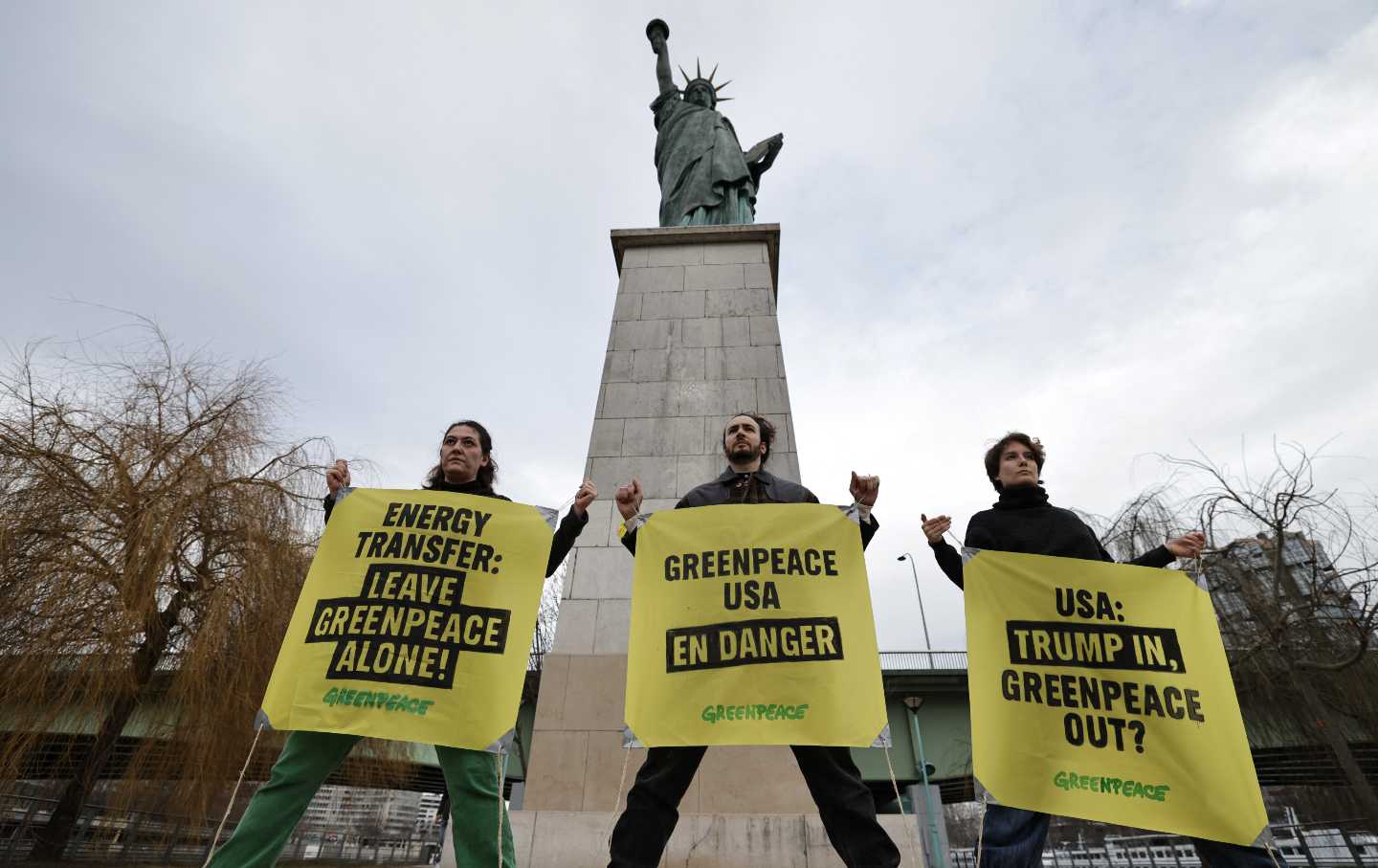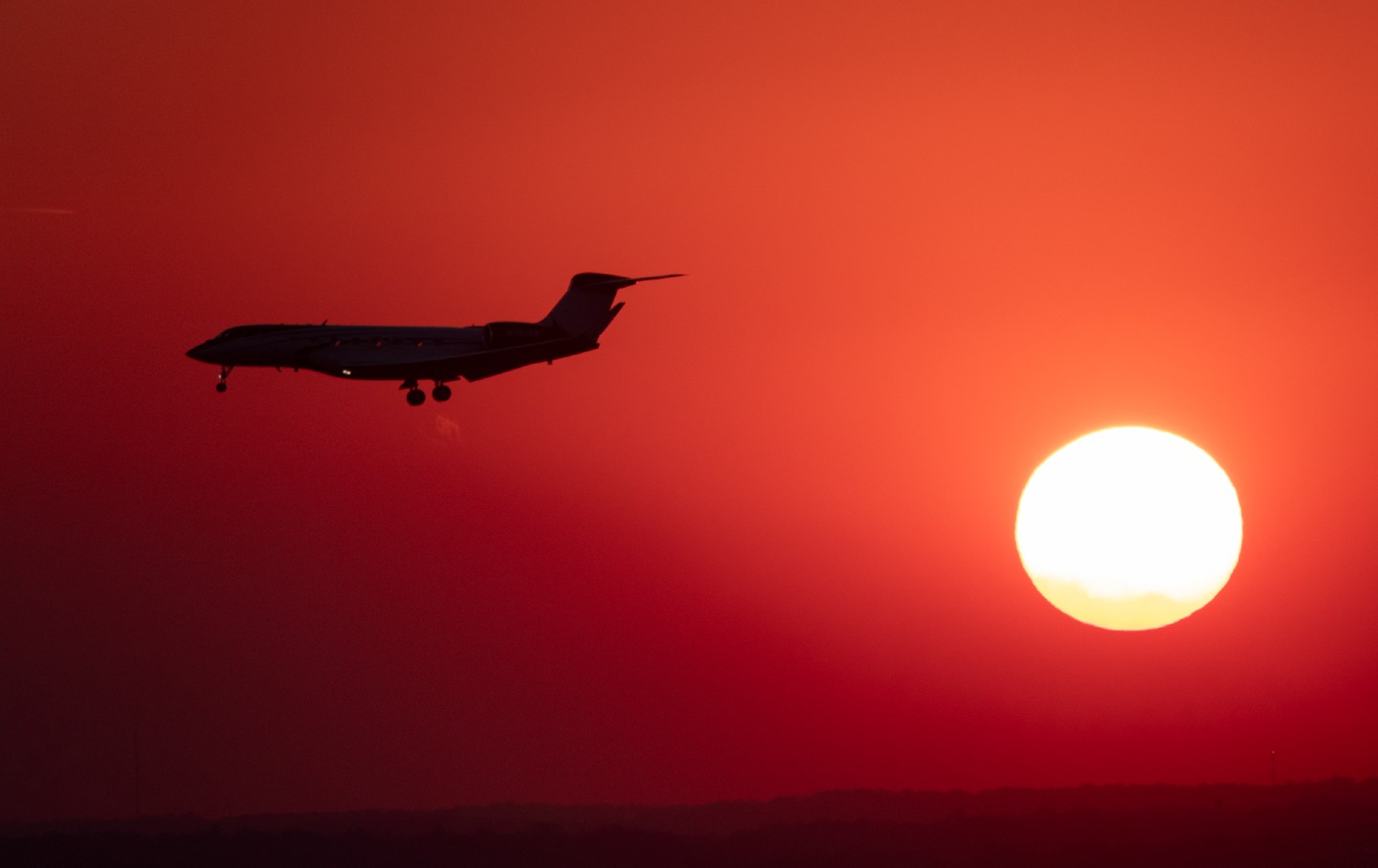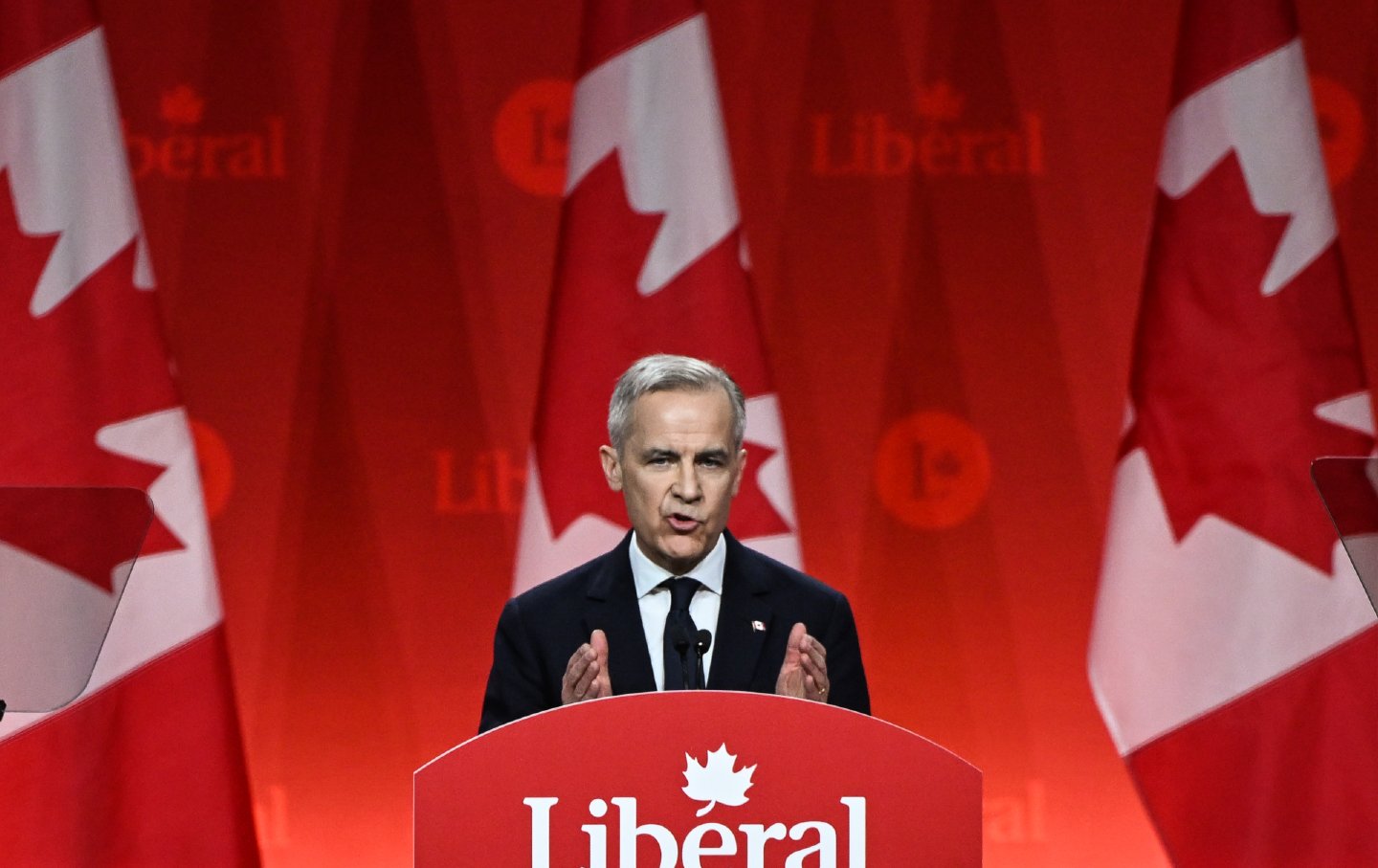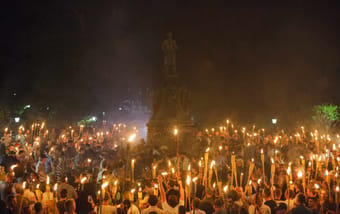The Media’s Mega-Failure on LA’s Mega-Fires
Even as the LA fires still burn, most journalism is not representing how the climate crisis is driving increasingly frequent and severe extreme weather.
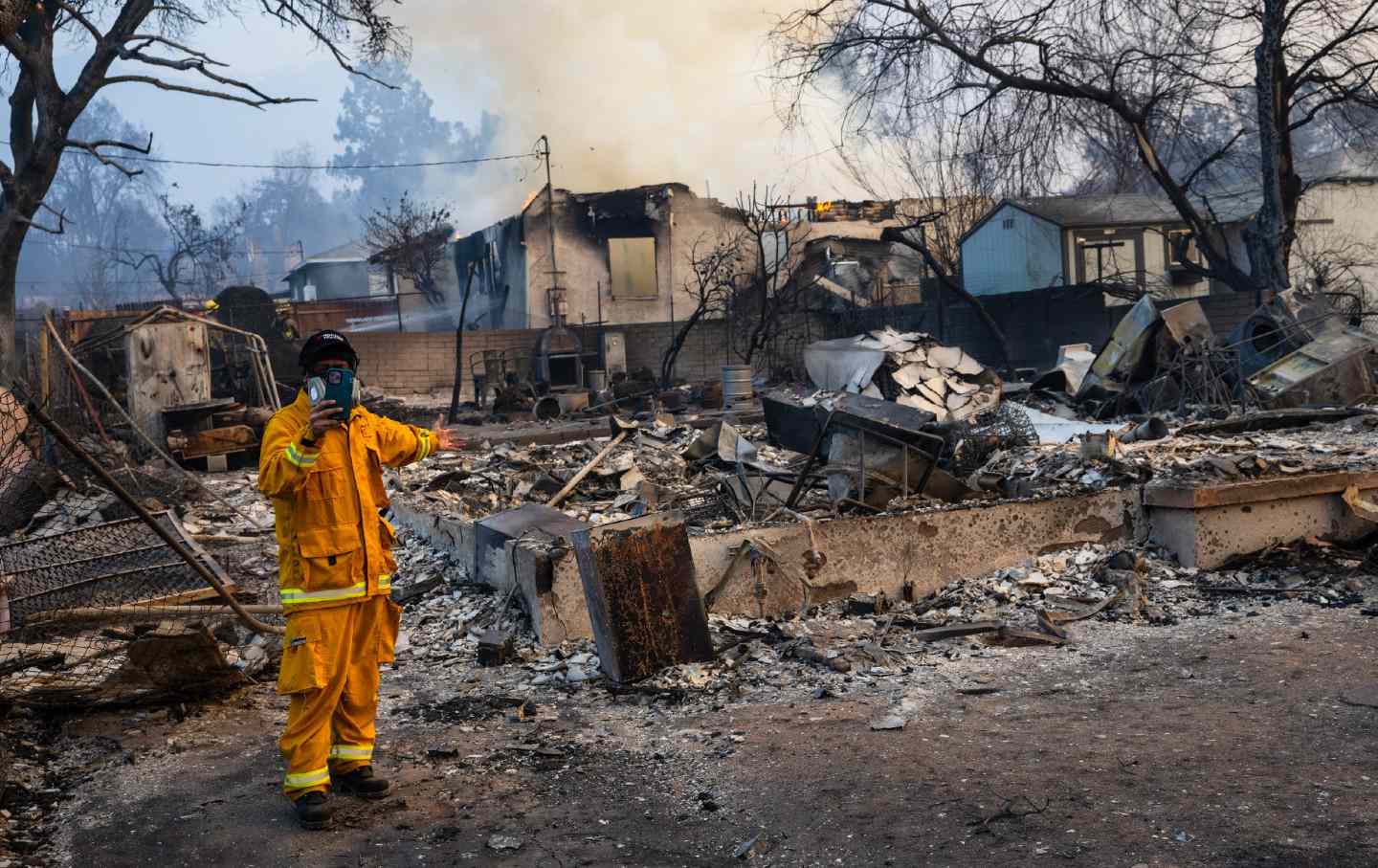
A reporter works in front of a home burned by the Eaton Fire in Altadena, California, on January 9, 2025.
(Zoë Meyers / AFP)
Last week, as the Sunset fire was bearing down on her Los Angeles home, Allison Agsten approached a group of television news crews standing in her neighborhood. Did any of them plan to mention the role of climate change in their reporting?
The question was professional as well as personal for Agsten, who runs a climate journalism center at the University of Southern California and has trained reporters on how to connect the climate crisis to what’s happening in the world. She has lived in her home along Runyon Canyon, near Hollywood, for a decade.
At a moment when making the climate connection to these deadly fires seemed urgent to Agsten, she told us, she was disappointed by the response she received. One reporter said she “just was not sure how my news director feels about covering climate on the air.” Another was more interested in what Agsten might know about looting in the area and asked if she had any security-camera footage of the fire or of looting that could be used on air.
“It was disheartening because it’s my personal story, and it’s disheartening because it’s what I do for a living,” said Agsten, director of the USC Annenberg Center for Climate Journalism and Communication.
The Los Angeles fires represent a crucial moment for the climate crisis—and for journalism. These are not the wildfires of seasons past. They are mega-fires that have now burned an area larger than the entire city of San Francisco. They are likely to be the costliest disaster in US history, California’s governor, Gavin Newsom, has predicted. At last count, a staggering 6 million people remained under a critical fire threat.
Alas, these mega-fires have called forth a mega-failure by much of the news media. A review of coverage to date shows that most journalism is still not accurately representing how the climate crisis is upending our civilization by driving increasingly frequent and severe extreme weather.
Too much of the coverage has simply ignored the climate crisis altogether, an inexcusable failure when the scientific link between such mega-fires and a hotter, dryer planet is unequivocal. Too many stories have framed the fires as a political spat between President-elect Donald Trump and California elected officials instead of a horrifying preview of what lies ahead if humans don’t rapidly phase out fossil fuels. Too often, bad-faith disinformation has been repeated instead of debunked. And rarely have stories named the ultimate authors of this disaster: ExxonMobil, Chevron, and other fossil-fuel companies that have made gargantuan amounts of money even as they knowingly lied about their products dangerously overheating the planet.
As the cofounders of the global journalism collaboration Covering Climate Now, we have a unique view into what’s been missing from the first chapter of the LA fires coverage. But we can also see what has worked and could help our fellow journalists do better on future chapters of the story.
More extreme weather is inevitable. In a welcome exception to most coverage, Time published a powerfully illustrated cover story headlined “The LA fires show the reality of living in a world with 1.5C of warming.” In an implicit rebuke of Trump and other climate deniers, veteran climate reporter Jeffrey Kluger wrote that “fixing the problem first requires understanding— and, even more fundamentally, accepting—the science.” That science, he added, says that additional warming is unavoidable until humans stop burning fossil fuels.
When our planetary house is literally on fire, better news coverage is an essential climate solution. Climate activists have been sounding the alarm for decades. But until the general public—such as the countless working parents who are more focused on raising their kids than on following every twist and turn of current affairs—understands that our planetary house is on fire, why it’s on fire, and that humanity possesses all the tools needed to extinguish the fire (except for enough politicians who will deploy those tools), there simply will not be enough public pressure to get governments to change course.
Popular
“swipe left below to view more authors”Swipe →To be fair, there have been episodic examples of climate-savvy coverage of the fires. Individual stories by the Los Angeles Times, Variety, Axios, The Guardian, CBS News, ABC News, CNN, and others are worth noting, if only because they illustrate how easy it is to do better.
Sometimes, a single sentence is enough to tie these fires to the larger climate reality. And all the better if that sentence is the story’s lede. Sammy Roth, one of the very best climate journalists in the US, did exactly that in his January 14 “Boiling Point” column for the Los Angeles Times: “Los Angeles is burning. Fossil fuel companies laid the kindling.”
One canard sometimes heard in newsrooms is that talking about the climate crisis is misplaced, even disrespectful, during the initial stages of a disaster when people are fearing for their lives. Certainly journalists should always remember our public service responsibility to provide timely, accurate information about evacuation routes and the like. But we can do that while also informing the public about why such disasters are happening in the first place.
Space is especially at a premium in TV and radio journalism, where reporters sometimes squabble with their producers for an extra 10 seconds of air time. But that didn’t stop CBS News from making the climate connection when using the LA fires as a news peg when examining former president Jimmy Carter’s efforts against the climate crisis. It took CBS’s anchor Lindsey Reiser just six seconds to open her piece with the words, “The wildfires in California are the latest in a string of natural disasters made worse by climate change.”
Of course, TV needs pictures to tell the story, and brave photographers have provided stunning images of the LA fires. But it’s an editorial choice what narration is paired with such images, and again, it doesn’t take long to make the climate connection. A 30-second weather segment on ABC’s Good Morning America showed harrowing video of the Palisades fire while meteorologist Somara Theodore told viewers, “As the climate is changing, we are seeing that these wildfires are becoming more extreme.” The rise in global temperatures, she added, has meant that “41 percent more land [has burned] as a result.”
More from Covering Climate Now:
One of the most distressing fails has been the way too many news outlets took statements by Trump, Elon Musk, and other known peddlers of disinformation at face value and even began framing their coverage of the fires accordingly. After Trump and Musk blasted false claims last week about how California environmental and DEI policies were impeding a rapid response to the fires, reports by leading news organizations began echoing those questions about whether local and state officials were properly prepared for this disaster.
Again, exceptions to the rule show how easy it would have been for those outlets to identify and debunk such disinformation instead. Some of the best work here was done by California outlets, including the public radio stations KQED and LAist. An added bonus of such debunking? It gains the public’s trust in the news outlet, which in turn can build the audience and revenues that independent journalism desperately needs going forward.
Journalists have understandably wanted answers about what caused these fires. Was it arson, or downed power lines, or something else? Of course, it’s important to understand the proximate cause of these terrible blazes. But zeroing in only on the spark misses the bigger truth. We would not be living this particular catastrophe without an overheated climate.
Let’s listen to what our USC colleague Allison Agsten is telling us. For now, her home is spared. But strong winds are picking up again, and emergency officials are warning of more fires to come. When a house is on fire, by all means let journalism show us the flames. But tell us why the house is burning, too.


